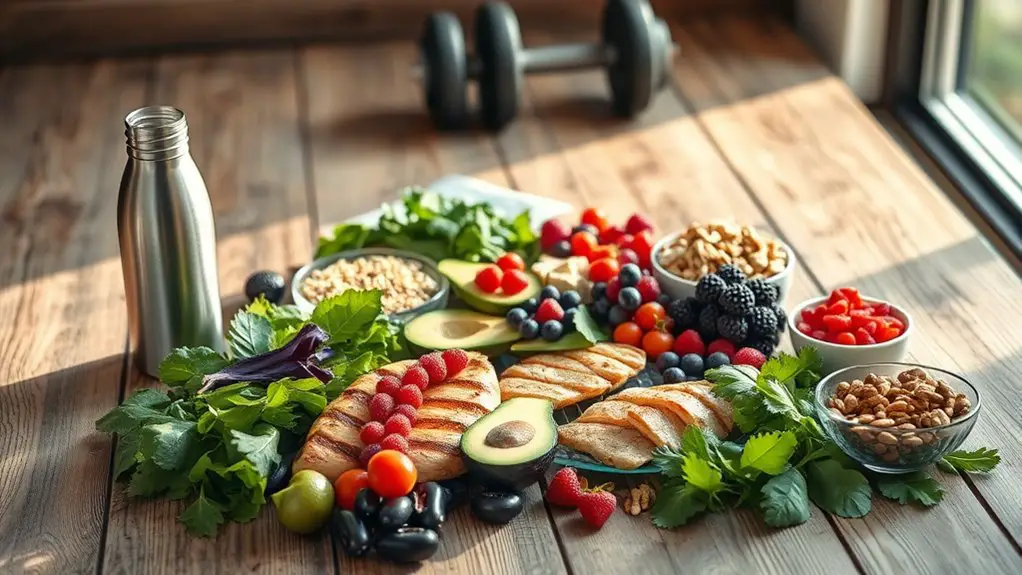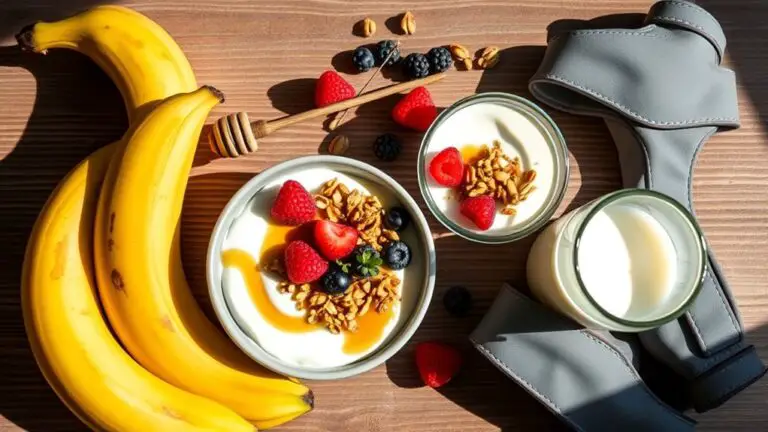How to Stay in a Caloric Deficit While Training Hard

To stay in a caloric deficit while training hard, start by calculating your Total Daily Energy Expenditure (TDEE) and subtract 500-750 calories for weight loss. Focus on nutrient-dense foods, including lean proteins, whole grains, and veggies. Eat balanced meals around workouts for energy and recovery. Incorporate smart snacks to maintain fullness. Stay hydrated and prioritize sleep for peak performance. Track your progress to adjust as needed; there’s more to explore about achieving your goals effectively.
Understand Your Caloric Needs

Understanding your caloric needs is vital for maintaining a caloric deficit, especially when you’re training hard. To achieve this, you’ll need to perform accurate caloric calculations. Start by determining your Total Daily Energy Expenditure (TDEE), which accounts for your basal metabolic rate and the calories burned during physical activity.
Once you know your TDEE, subtract 500 to 750 calories to create a sustainable deficit, promoting fat loss while still fueling your workouts. It’s important to maintain an appropriate energy balance; if you cut calories too drastically, you risk losing muscle and impacting your performance.
Track your food intake to guarantee you stay within your caloric limit, and adjust as needed based on your progress. Remember, being mindful of your caloric needs will help you stay focused and energized, ultimately making your training more effective and enjoyable. Incorporating exercises like skipping rope, which can burn approximately 11.6 calories per minute, can also aid in maintaining your caloric deficit.
Optimize Meal Timing for Performance
When you optimize meal timing, you can greatly enhance your training performance and recovery. Focus on having balanced pre workout meals about 1-3 hours before your session. Incorporate carbohydrates and protein to fuel your workout and minimize muscle breakdown. For example, a banana with a scoop of protein powder or oatmeal with berries can work wonders.
After your workout, prioritize post workout nutrition within 30-60 minutes. This is your window to replenish glycogen stores and kickstart muscle recovery. Aim for a mix of protein and carbs, like a protein shake with a piece of fruit or chicken with sweet potatoes.
Focus on Nutrient-Dense Foods

To maintain a caloric deficit while training hard, focusing on nutrient-dense foods is crucial. Prioritizing food quality guarantees you’re getting the vitamins and minerals your body needs without excessive calories. Here are four nutrient-dense options to take into account:
Focusing on nutrient-dense foods is essential for maintaining a caloric deficit while ensuring your body gets necessary vitamins and minerals.
- Leafy Greens: Foods like spinach and kale are low in calories but packed with fiber, vitamins, and minerals.
- Lean Proteins: Chicken breast, turkey, and fish provide essential amino acids and help you feel full longer.
- Whole Grains: Quinoa and brown rice offer complex carbohydrates along with fiber, keeping your energy levels stable.
- Colorful Vegetables: Bell peppers, carrots, and broccoli are high in nutrients and low in calories, making them perfect for filling your plate.
Incorporate Smart Snacking Strategies
While it might seem challenging to snack smartly when you’re in a caloric deficit, choosing the right snacks can actually support your training goals and keep hunger at bay. Focus on healthy snack options that are high in protein and fiber, like Greek yogurt, raw veggies with hummus, or a handful of nuts. These choices help you feel full longer, making it easier to stick to your caloric goals.
Mindful eating plays an essential role here. Take the time to savor each bite and listen to your body’s hunger cues. This approach not only enhances your enjoyment of food but also helps prevent overeating. Plan your snacks ahead of time to avoid impulsive choices that might derail your progress. By incorporating these smart snacking strategies, you’ll fuel your workouts while maintaining a caloric deficit, striking that perfect balance between satisfaction and discipline.
Monitor Your Progress and Adjust Accordingly

To effectively maintain your caloric deficit while training hard, you need to track your metrics closely. By monitoring your weight, body measurements, and performance, you can spot trends that indicate whether your current caloric intake is working. If you find your progress stalling, it might be time to adjust your caloric intake to stay on track. Additionally, using a calorie calculator can help you determine your personalized intake needs for optimal results.
Track Your Metrics
Tracking your metrics is essential for staying on course in a caloric deficit, especially when you’re training hard. By monitoring your progress, you can make informed decisions that align with your fitness goals. Here are four key areas to focus on:
- Caloric Tracking: Keep a daily log of your calorie intake to guarantee you’re maintaining a deficit.
- Activity Metrics: Record your workouts, including intensity and duration, to gauge your caloric burn.
- Body Measurements: Take regular measurements of your weight, waist, and other areas to track changes over time.
- Energy Levels: Note how you feel during workouts and daily activities to adjust your diet if needed.
Adjust Caloric Intake
After you’ve established a solid system for tracking your metrics, the next step is adjusting your caloric intake based on your progress. It’s essential to monitor how your body responds to your current caloric levels. If you’re not seeing the desired results, consider implementing caloric cycling—alternating higher and lower calorie days can stimulate metabolism while preventing plateaus. Also, practice portion control; measuring your food can help you stay within your target intake more effectively. Remember that as you lose weight or increase your training intensity, your caloric needs may change. Regularly reassess your metrics and adjust your intake accordingly to maintain that caloric deficit while supporting your training goals. Stay flexible and responsive to your body’s signals.
Stay Hydrated and Prioritize Recovery
Staying hydrated is essential for optimizing your performance and recovery when you’re in a caloric deficit. Quality rest and sleep, along with strategic nutrient timing, play significant roles in how well your body repairs and replenishes itself after training. By prioritizing these elements, you’ll support your fitness goals while maintaining your energy levels. Additionally, understanding the potential for muscle loss during periods of inactivity can help you stay motivated to stick to your training regimen.
Importance of Water Intake
One of the most overlooked aspects of maintaining a caloric deficit while training hard is proper hydration. Staying hydrated not only supports your performance but also enhances recovery. Here are some hydration benefits you shouldn’t ignore:
- Increased Energy Levels: Adequate water intake helps prevent fatigue, keeping your energy up for workouts.
- Enhanced Metabolism: Drinking water can boost your metabolic rate, aiding in fat loss.
- Muscle Function: Proper hydration supports muscle contractions and reduces cramping.
- Effective Nutrient Transport: Water helps transport nutrients from food sources, maximizing your caloric intake efficiency.
To meet your hydration needs, prioritize water from various sources such as fruits, vegetables, and herbal teas. Staying on top of your hydration game will greatly support your training efforts.
Rest and Sleep Quality
While you may focus on your workouts and nutrition, neglecting rest and sleep quality can undermine your efforts to stay in a caloric deficit. Prioritizing sleep hygiene is essential; create a sleep environment that’s dark, cool, and quiet. Implement relaxation practices like deep breathing or meditation to help with stress management, which can greatly impact your sleep quality. Recovery techniques such as foam rolling or gentle stretching before bed can also promote better sleep. Aim for 7-9 hours of quality sleep each night to support muscle recovery and hormone regulation. Remember, without proper rest, your body struggles to recover, making it harder to maintain that caloric deficit, so take your sleep seriously.
Nutrient Timing Strategies
To effectively manage a caloric deficit during intense training, understanding nutrient timing is essential. Here are some practical strategies to help you optimize your performance and recovery:
- Pre-Workout Nutrition: Fuel your body with a balanced meal rich in carbohydrates and protein about 1-2 hours before training to boost energy levels.
- Carbohydrate Timing: Post-workout, prioritize carbohydrates to replenish glycogen stores and enhance nutrient absorption.
- Protein Distribution: Spread your protein intake throughout the day to support muscle recovery and maintain energy balance.
- Meal Frequency: Consider multiple smaller meals to align with fasting strategies, helping to stabilize blood sugar levels and improve nutrient absorption.
Stay hydrated and focus on post-workout recovery to maximize your results while in a caloric deficit.
Frequently Asked Questions
Can I Drink Alcohol While Maintaining a Caloric Deficit?
Enjoying a little liquid cheer can be tempting, but it’s essential to tread carefully. If you’re keen on sipping, focus on smart alcohol choices—opt for lighter options like wine or spirits mixed with low-calorie sodas. Remember, moderation strategies are key; limit your intake to maintain control over your caloric intake. Just keep in mind that while you can indulge occasionally, it’s vital to balance those treats with your overall goals.
How Do I Handle Social Events and Eating Out?
Handling social events and eating out can be tricky, but with some social strategies, you can enjoy yourself without derailing your goals. Before you go, check the menu online for healthier options. When dining, stick to smaller portions or share dishes. Focus on protein and veggies, and limit high-calorie sides. Don’t forget to stay hydrated with water, and remember, it’s okay to indulge occasionally—balance is key to long-term success!
Is Intermittent Fasting Effective for Staying in a Caloric Deficit?
Imagine a marathon runner pacing themselves, knowing when to push and when to conserve energy. Intermittent fasting can be similar; it’s effective for staying in a caloric deficit. Studies show its benefits, like improved insulin sensitivity and fat loss. By sticking to a fasting schedule, you can simplify meal planning and reduce late-night snacking. Experiment with different fasting schedule strategies to find what suits you best, ensuring you stay focused on your goals.
What Are Some Low-Calorie Meal Options for Athletes?
When you’re looking for low-calorie meal options, focus on nutrient-dense meals that fuel your training. Think about incorporating lean proteins like grilled chicken or tofu, paired with plenty of veggies. For snacks, consider protein-packed options like Greek yogurt with berries or a handful of nuts. These choices not only keep calories in check but also provide the energy and recovery support you need for your workouts.
How Does Sleep Impact My Caloric Deficit and Training?
Sleep’s essential for your caloric deficit and training. Poor sleep quality can hinder recovery, making it harder to stick to your deficit and perform well. When you’re well-rested, your body recovers efficiently, supporting muscle growth and fat loss. Aim for 7-9 hours of quality sleep each night to optimize your performance and maintain that deficit. Prioritize sleep as part of your training regimen; it’s just as important as your workouts and nutrition.





